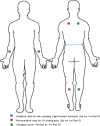A controlled cross-over study to evaluate the efficacy of improvised dry and wet emergency decontamination protocols for chemical incidents
- PMID: 33147217
- PMCID: PMC7641342
- DOI: 10.1371/journal.pone.0239845
A controlled cross-over study to evaluate the efficacy of improvised dry and wet emergency decontamination protocols for chemical incidents
Abstract
The UK Initial Operational Response (IOR) to chemical incidents includes improvised decontamination procedures, which use readily available materials to rapidly reduce risk to potentially exposed persons. A controlled, cross-over human volunteer study was conducted to investigate the effectiveness of improvised dry and wet decontamination procedures on skin, both alone, and in sequence. A simulant contaminant, methyl salicylate (MeS) in vegetable oil with a fluorophore was applied to three locations (shoulder, leg, arm). Participants then received no decontamination (control) or attempted to remove the simulant using one of three improvised protocols (dry decontamination; wet decontamination; combined dry and wet decontamination). Simulant remaining on the skin following decontamination was quantified using both Gas Chromatography Tandem Mass Spectrometry (GC-MSMS) for analysis of MeS and UV imaging to detect fluorophores. Additionally, urine samples were collected for 24 hours following application for analysis of MeS. Significantly less simulant was recovered from skin following each improvised decontamination protocol, compared to the no decontamination control. Further, combined dry and wet decontamination resulted in lower recovery of simulant when compared to either dry or wet decontamination alone. Irrespective of decontamination protocol, significantly more simulant remained on the shoulders compared to either the arms or legs, suggesting that improvised decontamination procedures are less effective for difficult to reach areas of the body. There was no effect of decontamination on excreted MeS in urine over 24 hours. Overall, findings indicate that improvised decontamination is an effective means of rapidly removing contaminants from skin, and combinations of improvised approaches can increase effectiveness in the early stages of decontamination and in the absence of specialist resources at an incident scene. However, the variable control and consistency of improvised decontamination techniques means that further intervention is likely to be needed, particularly for less accessible areas of the body.
Conflict of interest statement
The authors have declared that no competing interests exist.
Figures








References
-
- Home Office. Initial operational response to a CBRN incident. 2015. Available at https://www.jesip.org.uk/uploads/media/pdf/CBRN%20JOPs/IOR_Guidance_V2_J....
-
- Maynard RL, Chilcott RP. Toxicology of chemical warfare In: Ballantyne B, Marrs TC, Syversen T, editors. General and Applied Toxicology: John Wiley & Sons; 2009.
-
- Matar H, Larner J, Kansagra S, Atkinson KL, Skamarauskas JT, Amlot R, et al. Design and characterisation of a novel in vitro skin diffusion cell system for assessing mass casualty decontamination systems. Toxicol In Vitro. 2014;28(4):492–501. Epub 2014/01/15. 10.1016/j.tiv.2014.01.001 . - DOI - PubMed
-
- Amlot R, Carter H, Riddle L, Larner J, Chilcott RP. Volunteer trials of a novel improvised dry decontamination protocol for use during mass casualty incidents as part of the UK'S Initial Operational Response (IOR). PLoS One. 2017;12(6):e0179309 Epub 2017/06/18. 10.1371/journal.pone.0179309 - DOI - PMC - PubMed
Publication types
MeSH terms
Substances
Grants and funding
LinkOut - more resources
Full Text Sources
Miscellaneous

